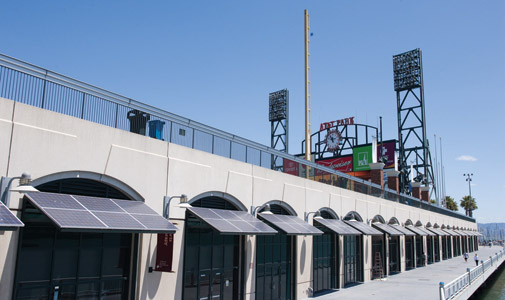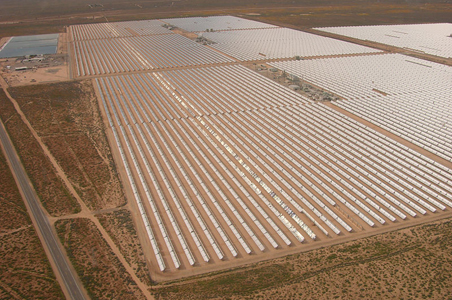Bay Area lawmakers have made serious headway recently in the effort to create incentives for commercial and residential solar application. And local agencies say that the expected spike in solar-generated wattage will make the Bay Area a solar model for other parts of the country.

PG&E’s solar PV installations at AT&T Park which feed renewable energy into the grid for PG&E customers. Photo courtesy of PG&E
By Bill Picture
Published: August, 2008
On June 18, San Francisco Mayor Gavin Newsom signed into law the City’s Solar Energy Incentive Program, the most ambitious municipal incentive program of its kind to date in the United States. We are very happy with the outcome, says Johanna Partin, Renewable Energy Program Manager for the San Francisco Department of the Environment. And we believe this is really going to be a boon for solar.
Under the program, San Francisco residents will be able to recoup up to $6,000 on the cost of a home solar system. And businesses will be able to recoup up to $10,000.
As is the case with most legislation, politics itself slowed the program’s approval by the San Francisco Board of Supervisors. First drafted in 2007 by the Mayor-convened Solar Task Force and sponsored by Newsom himself, the program initially failed to garner the number of ayes needed to become law. A near-carbon copy of the bill—including an additional incentive level and featuring a new sponsor, Supervisor Bevan Dufty—along with a partner bill sponsored by Supervisor Ross Mirkarimi providing additional incentives to non-profit entities, was approved in early June.
The program sets aside $3 million annually for ten years for the paybacks outlined. That may sound like a lot of money, but Partin recommends that San Franciscans who may be considering going solar do so soon. There is already so much interest in the program, she says. We’re definitely going to hit that $3 million cap. To ensure that happens, the Public Utilities Commission is pulling out all of the marketing stops. And local solar installers are launching their own ad campaigns to help spread the word.
Under the Solar Energy Incentive Program, San Franciscans can get additional money for hiring a City-based installer, and even more for hiring an installer that employs graduates of a City-sponsored workforce development program. The San Francisco Department of the Environment is also organizing open-house events throughout the City to promote the program at a neighborhood level.
On the road to the Senate floor
Assemblyman Jared Huffman (D-San Rafael) reports that his bill, AB1920, which would require that solar system owners be reimbursed for any surplus energy fed into the utility companies’ power grid, is moving slowly but steadily. The bill is waiting for a second run-through by the State Senate’s Appropriations Committee, after which, if it passes, it will go before the full Senate.
We’re making progress, says Huffman. And I remain optimistic, cautiously optimistic. I don’t want to jinx it, he jokes.
The original bill underwent several rounds of tweaks before getting to this phase. The largest tweak, according to Huffman, was removing language that would have done away with the so-called size-to-load rule. That rule states that a home or business can only install a solar system large enough to meet its existing energy needs, and prohibits installing anything larger.
You’d think that installing a larger system than you need and generating more power would be a good thing, right? Huffman explains. But it was a deal-breaker for the utility companies and the regulators. They were emphatic that residential solar energy be limited to offsetting energy demands. But, even with this amendment, Huffman says that solar system owners stand to make a few bucks if AB1920 passes. According to the Assemblyman, not only are more and more Californians investing in solar systems. They are also finding ways to be more energy-efficient.
According to Huffman, a homeowner who installed a solar system one year ago is producing the same amount of electricity but probably using less than they did at the time of installation. AB1920 would make sure that homeowner gets reimbursed for the surplus energy they produce.
The size-to-load rule was also recently amended by regulators to allow up to a 5-kilowatt system with no questions asked. And it allows for an even larger system if the homeowner can show a future demand increase. For instance, if the homeowner were planning to purchase an electric car, they would be allowed to install a larger system to accommodate that.
Assuming there are no further bureaucratic roadblocks, Huffman says the bill could be signed into law next year. What everyone has to remember is that [AB1920] isn’t about making homeowners rich, he adds. It’s just another helpful incentive for people. And a little incentive goes a long way.
Moving forward
While playing to Californians’ sense of environmental responsibility as a means of promoting the use of renewable sources of energy is great in theory, cost has proven a bigger factor.
The Cambridge, Massachusetts-based Prometheus Institute for Sustainable Development was the latest to report on an expected flood of available silicon that experts predict will significantly lower the cost of solar system production. A shortage of available silicon has been blamed for the slowing decrease in cost to consumers over the last few years.
But, while many consumers wait for solar prices to fit within their current budgets, basing their energy decisions largely on cost, more local governments and utility companies are weighing cost and conscience equally, and moving forward with plans to produce and buy more renewable energy. The goal, they say, is to lead the masses by example. San Francisco, for instance, recently selected an installer to install the third-largest city-funded solar system in the country on the rooftops of two city-owned properties. The electricity generated will provide power for city buildings and other municipal facilities, including schools, libraries and SFO.
And PG&E recently signed a long-term contract to buy solar-generated electricity from Oakland-based Bright Source Energy. Bright Source Energy plans to build and operate several solar-thermal plants in the Mojave Desert. While no one is keeping statistics on solar deals such as this one, PG&E’s contract with Bright Source Energy is believed to be the largest in solar history.
The plants will utilize new solar-thermal technology developed by Bright Source Energy itself. Thousands of robotic mirrors, arranged in a saucer shape, will automatically adjust themselves to reflect sunlight on a tower at the center of the arrangement. That tower will feature a water boiler, the contents of which will heat up to produce high-pressure steam that is then converted into electricity.
The first plant is expected to come online in 2011, and is expected to produce 100 megawatts of electricity. That is enough juice to power roughly 70,000 homes.
When all 900 megawatts of plants are completed, they will supply about 630,000 homes in the aggregate, says Charles Ricker, Senior VP of Marketing and Business Development at Bright Source Energy.
We are aggressively adding renewables to our portfolio, says PG&E spokesperson Jennifer Zerwer. It is a key focus for us. When looking to meet growing demand, we follow California’s loading order, and seek to do so first through energy efficiency programs and demand response programs. Second in the loading order is renewable energy. The last option is fossil fuels.
PG&E is also looking into building solar plants of its own, and eliminating the middleman altogether, as well as exploring other potential sources of renewable electricity, including wave energy and biomethanation. We do believe in leading by example, Zerwer adds. That is why we are committed to adding renewable energy as quickly as possible.

Robotic mirrors reflect sunlight onto the solar boiler at a test site in Israel’s Negev Desert, that creates steam, which is converted into electricity. Photo Courtesy of Bright Source Energy

PG&E signed an agreement with Martifer for over 106 MW of renewable solar-thermal biogas hybrid power. Photo Courtesy of PG&E

